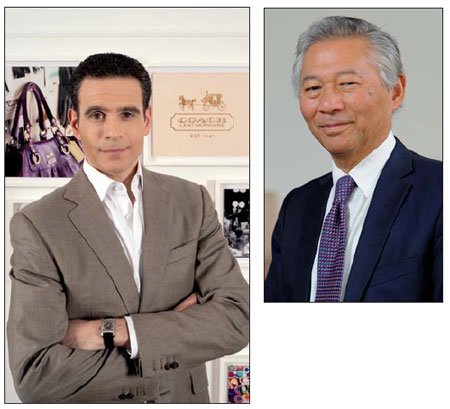Setting the price
Updated: 2012-09-28 08:47
By Wang Chao (China Daily)
|
||||||||
|
Coach Inc is one of the first companies to realize the perception of Chinese consumers and profit from its early moves. Provided to China Daily |
Seliger is well aware of the purchasing agents and the queues of Chinese customers outside the Coach factory stores in the US. "We are happy to see increasing engagement with Chinese customers in both China and overseas markets," he says.
Seliger says the US company has a way to deal with this situation as it frequently updates the product lineup with new designs (almost every month). "So even those who fly frequently between China and the US may find it hard to find the very bag they are looking for in a Coach outlet," he says.
"As Coach offers monthly newness and products tailored for local markets, we believe the accessible pricing and local promotional initiatives are enough incentives to boost domestic consumption," Seliger says.
"We do not offer traditional products that last for 10 plus years like many other European brands."
At the same time, most of the Coach products in China are priced at about half the price of traditional European luxury brands.
"In terms of pricing, our products in each of the markets is priced 40-60 percent lower than most other European brands," he says. "Coach has always been positioned as an accessible luxury brand since its inception in 1941."
The unique positioning helps the US company differentiate itself from European brands which are at the top of the pyramid and target only a small group of exclusive customers, as well as the "mass market" brands that appeal to the general public.
"We work with the fast-growing middle class in China," he says. "We want to be selective but not exclusive."
According to analysts, the gift consumption tradition in China has also helped brands charge higher prices. More than 25 percent of the luxury products purchases in China are for gifts, says a recent report released by US consultancy firm Bain & Co.
Jeff Gong, director of Beijing Vogue Glamour Brand Marketing Inc, a brand consultancy, says there is a huge difference between Chinese and Western consumption behavior. "While the Europeans love to keep the good stuff for the family, Chinese people present it to guests or to others as a gift."
Dale Preston, managing director of retail measurement in China at market research firm Nielsen, says pricing varies depending on the sectors, but what people are ultimately after is "value for money", whether it is for self-use or as a gift.
"If you are a premium brand, give customers a good story and good history; while for products displayed on the shelf like a shampoo, tell them what the product can do for your hair, whether it can make your hair shinier. If the product can deliver what it promises, then the brand image will be solidified," he says.
Gao from Tsinghua University says Chinese people's penchant for high-end brands will last for some time, and hence the brands will enjoy a considerably long "golden period" in China.
"As the disparity between different social classes is huge, the social hierarchy won't disappear in a short time. So Chinese people will keep chasing after brands and those beloved brands will always remain on a high perch for a while," he says.
|
Right: George Yip, co-director of the Center on China Innovation at CEIBS. Left: Jonathan Seliger, president and CEO of Coach China. Provided to China Daily |
Expensive affair
In modern society, pricing by cost is already too old-fashioned, especially when it comes to the service industry, brand experts say. Instead, "total experience" is fast becoming the selling point and also the money engine for international companies.
"You don't calculate the cost and then decide the price; that's really what we did 20 years ago," says Daniel Lutz, senior vice-president of Nestle Ltd, Greater China region. "Today we sell value to customers."
The pricing is dependent on consumer expectations, he says. "For example, if an ice cream is only for cooling down, you just need to make something from water and sugar, which will be very cheap; but if the customers' expectation is to indulge, they would like to pay more for products with milky chocolate and almonds on the top, which can be more expensive than the cost of the ingredients."
Coffee chains like Starbucks and Costa are companies that cater to this philosophy. Unlike the street corner coffee shops for "grab and go" that are common in Western countries, the two coffee chains have a more relaxed European aura at their Chinese stores: gentle lighting, soft music, comfortable couches and a smile pattern made of chocolate floating on the surface of the coffee.
As a country with a tea culture lasting thousands of years, Chinese customers did not really take to the innovations in the beginning. But the exotic atmosphere soon attracted many youngsters and executives.
The international pleasure experience does not come cheap. While thirsty people can get a good bottled coffee for 6 yuan in the convenience store, they have to shell out 25-40 yuan for a cup of coffee in Starbucks or Costa.
The over-popularity of these shops sometimes even becomes annoying to the owners. Addicted Chinese customers sit in the coffee shop all day long nursing a coffee and listening to music, thereby leading to lower customer footfalls than in Western countries.
In the US and Europe, Starbucks is identified with high quality but is not necessarily exclusive, says Mike Bastin, a researcher from the School of Contemporary Chinese Studies at Nottingham University. "But in China, Starbucks has a different meaning and is seen as a brand from America, and easily associated with a positive American image.
"Urban people like to reward themselves with these slightly expensive products to make them feel different and exclusive. If Starbucks lowers the price, it might cost the exclusivity of the brand, and customer erosion," he says.
Gavin White, group general manager of glo London, a British casual dining brand, finds similar preferences among his customers.
Although White was told to vary the tastes to cater to Chinese customers, he soon found out that customers want authentic and original British taste.

 Relief reaches isolated village
Relief reaches isolated village
 Rainfall poses new threats to quake-hit region
Rainfall poses new threats to quake-hit region
 Funerals begin for Boston bombing victims
Funerals begin for Boston bombing victims
 Quake takeaway from China's Air Force
Quake takeaway from China's Air Force
 Obama celebrates young inventors at science fair
Obama celebrates young inventors at science fair
 Earth Day marked around the world
Earth Day marked around the world
 Volunteer team helping students find sense of normalcy
Volunteer team helping students find sense of normalcy
 Ethnic groups quick to join rescue efforts
Ethnic groups quick to join rescue efforts
Most Viewed
Editor's Picks

|

|

|

|

|

|
Today's Top News
Chinese fleet drives out Japan's boats from Diaoyu
Health new priority for quake zone
Inspired by Guan, more Chinese pick up golf
Russia criticizes US reports on human rights
China, ROK criticize visits to shrine
Sino-US shared interests emphasized
China 'aims to share its dream with world'
Chinese president appoints 5 new ambassadors
US Weekly

|

|









